Project Management Plan: Removal of the Public Train Line, NSW
VerifiedAdded on 2020/10/22
|41
|8575
|199
Project
AI Summary
This project management plan focuses on the removal of the public train line between Warabrook and Maitland, NSW. It begins with an introduction that highlights the project's background and the business need for removing the degraded train lines due to safety concerns and operational issues. The plan outlines project goals and objectives, including evaluating removal methods, examining intermediaries, analyzing problems, and recommending strategies. It details the project scope, including requirements, deliverables, and constraints. The plan also covers significant milestones, budget considerations, and key stakeholders. The project management approach utilizes the Agile construction methodology, breaking the project into manageable steps with frequent reviews. Strategies include sharing objectives with stakeholders, explaining the project's scope, and identifying potential challenges. Scope management includes a scope statement, work breakdown structure, and scope control plan. Furthermore, it includes requirements management, stakeholder management, risk management, schedule management, ethics management, cost management, human resource management, and communication management. The plan provides a comprehensive overview of the project's various aspects, from initial planning to execution and control, ensuring a structured approach to the removal of the train line.
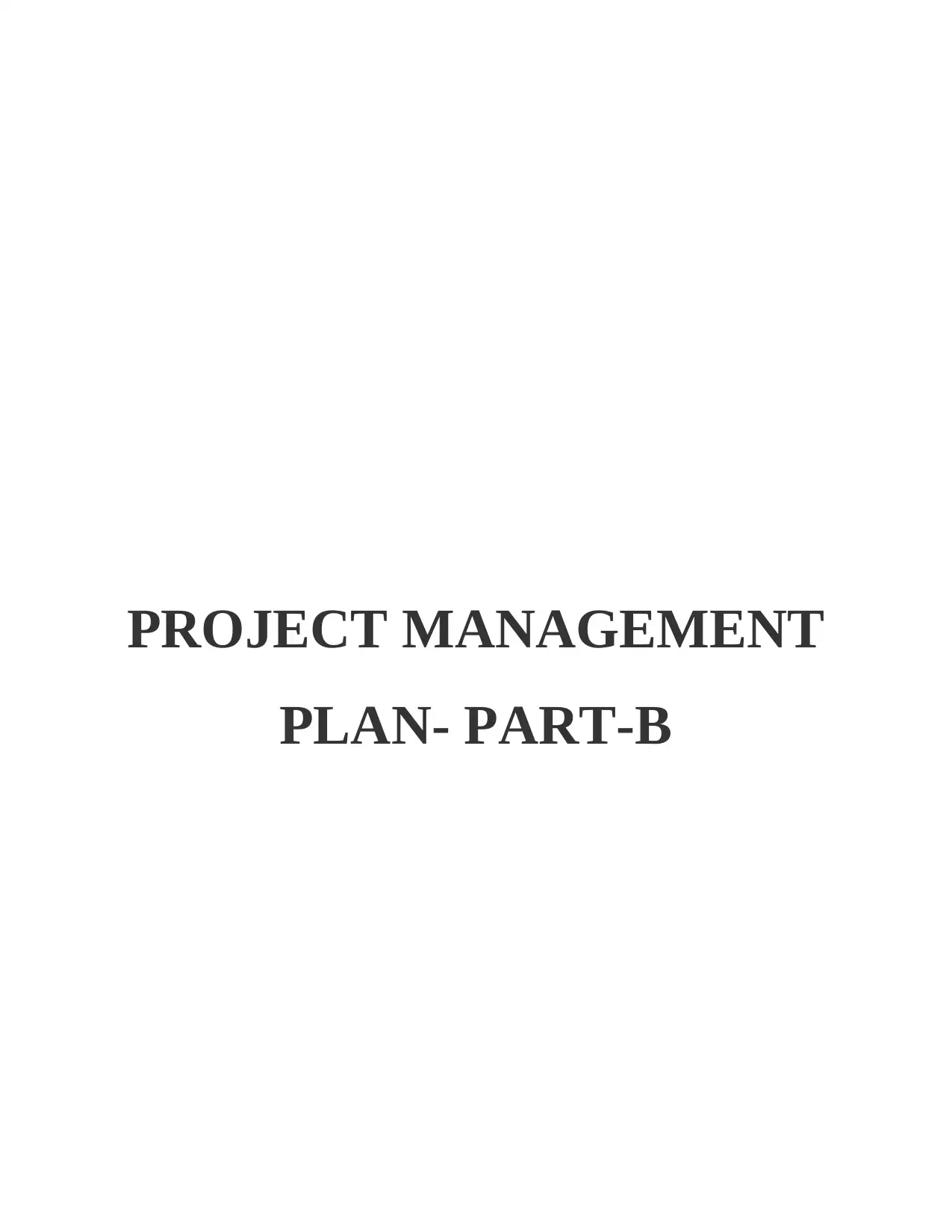
PROJECT MANAGEMENT
PLAN- PART-B
PLAN- PART-B
Paraphrase This Document
Need a fresh take? Get an instant paraphrase of this document with our AI Paraphraser
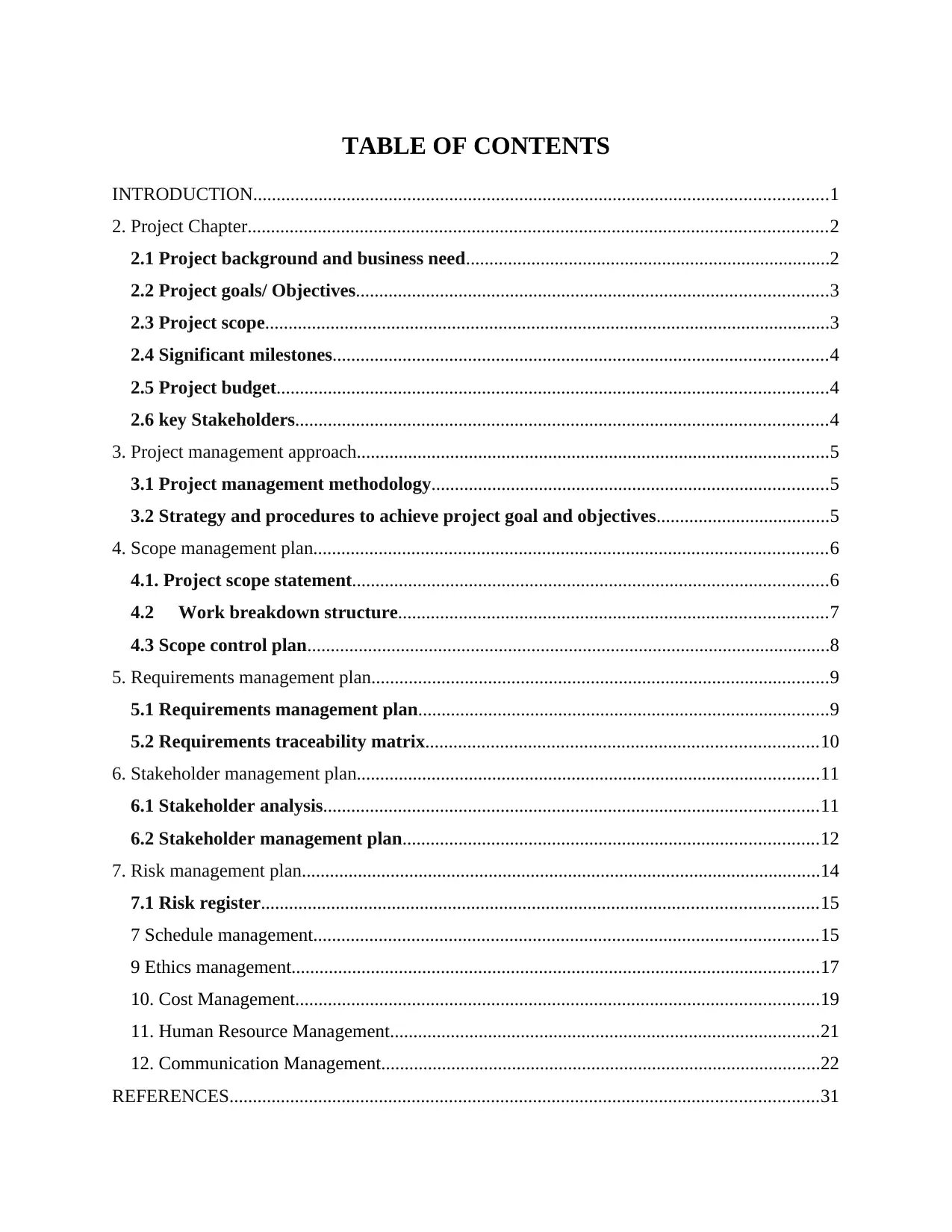
TABLE OF CONTENTS
INTRODUCTION...........................................................................................................................1
2. Project Chapter............................................................................................................................2
2.1 Project background and business need..............................................................................2
2.2 Project goals/ Objectives.....................................................................................................3
2.3 Project scope.........................................................................................................................3
2.4 Significant milestones..........................................................................................................4
2.5 Project budget......................................................................................................................4
2.6 key Stakeholders..................................................................................................................4
3. Project management approach.....................................................................................................5
3.1 Project management methodology.....................................................................................5
3.2 Strategy and procedures to achieve project goal and objectives.....................................5
4. Scope management plan..............................................................................................................6
4.1. Project scope statement......................................................................................................6
4.2 Work breakdown structure............................................................................................7
4.3 Scope control plan................................................................................................................8
5. Requirements management plan..................................................................................................9
5.1 Requirements management plan........................................................................................9
5.2 Requirements traceability matrix....................................................................................10
6. Stakeholder management plan...................................................................................................11
6.1 Stakeholder analysis..........................................................................................................11
6.2 Stakeholder management plan.........................................................................................12
7. Risk management plan...............................................................................................................14
7.1 Risk register.......................................................................................................................15
7 Schedule management............................................................................................................15
9 Ethics management.................................................................................................................17
10. Cost Management................................................................................................................19
11. Human Resource Management............................................................................................21
12. Communication Management..............................................................................................22
REFERENCES..............................................................................................................................31
INTRODUCTION...........................................................................................................................1
2. Project Chapter............................................................................................................................2
2.1 Project background and business need..............................................................................2
2.2 Project goals/ Objectives.....................................................................................................3
2.3 Project scope.........................................................................................................................3
2.4 Significant milestones..........................................................................................................4
2.5 Project budget......................................................................................................................4
2.6 key Stakeholders..................................................................................................................4
3. Project management approach.....................................................................................................5
3.1 Project management methodology.....................................................................................5
3.2 Strategy and procedures to achieve project goal and objectives.....................................5
4. Scope management plan..............................................................................................................6
4.1. Project scope statement......................................................................................................6
4.2 Work breakdown structure............................................................................................7
4.3 Scope control plan................................................................................................................8
5. Requirements management plan..................................................................................................9
5.1 Requirements management plan........................................................................................9
5.2 Requirements traceability matrix....................................................................................10
6. Stakeholder management plan...................................................................................................11
6.1 Stakeholder analysis..........................................................................................................11
6.2 Stakeholder management plan.........................................................................................12
7. Risk management plan...............................................................................................................14
7.1 Risk register.......................................................................................................................15
7 Schedule management............................................................................................................15
9 Ethics management.................................................................................................................17
10. Cost Management................................................................................................................19
11. Human Resource Management............................................................................................21
12. Communication Management..............................................................................................22
REFERENCES..............................................................................................................................31

⊘ This is a preview!⊘
Do you want full access?
Subscribe today to unlock all pages.

Trusted by 1+ million students worldwide
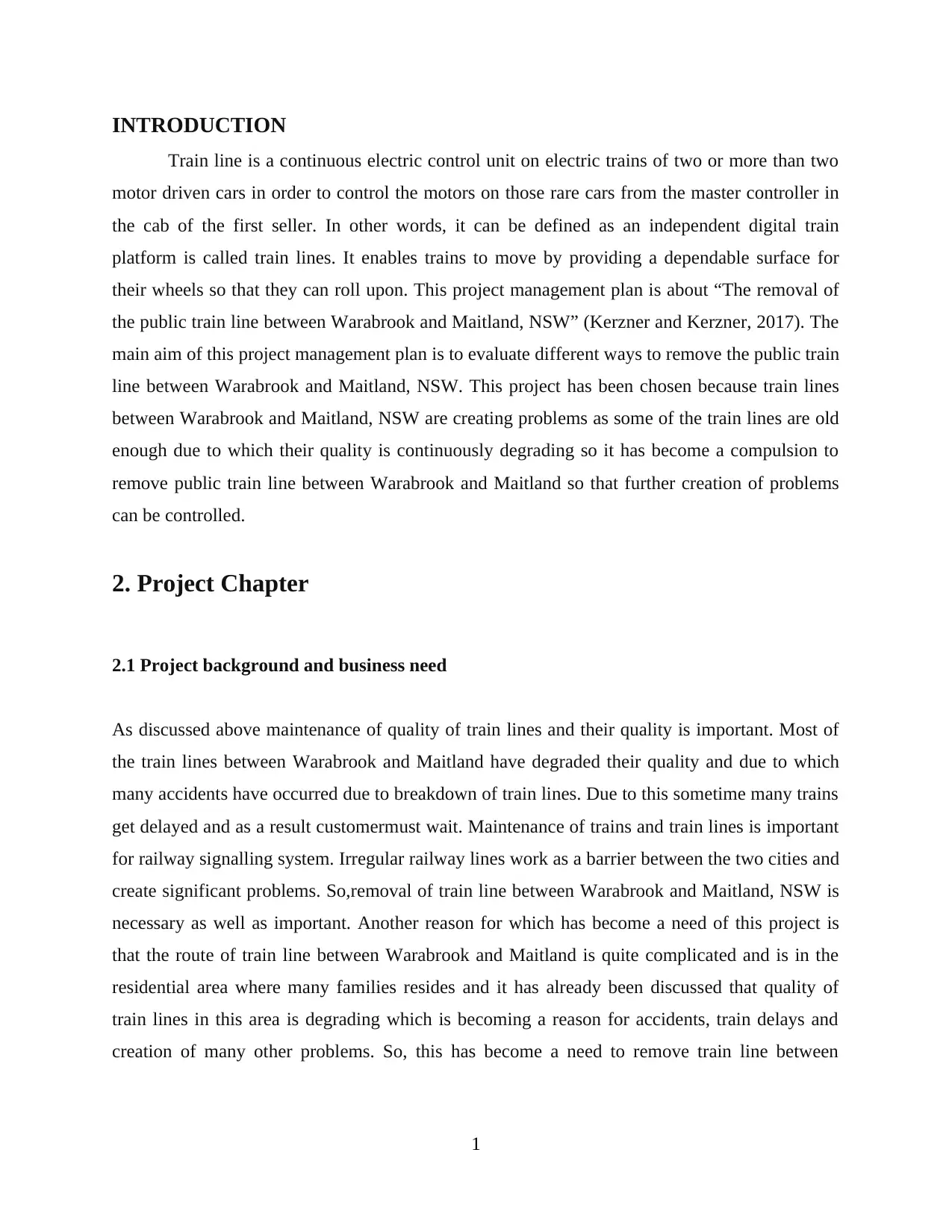
INTRODUCTION
Train line is a continuous electric control unit on electric trains of two or more than two
motor driven cars in order to control the motors on those rare cars from the master controller in
the cab of the first seller. In other words, it can be defined as an independent digital train
platform is called train lines. It enables trains to move by providing a dependable surface for
their wheels so that they can roll upon. This project management plan is about “The removal of
the public train line between Warabrook and Maitland, NSW” (Kerzner and Kerzner, 2017). The
main aim of this project management plan is to evaluate different ways to remove the public train
line between Warabrook and Maitland, NSW. This project has been chosen because train lines
between Warabrook and Maitland, NSW are creating problems as some of the train lines are old
enough due to which their quality is continuously degrading so it has become a compulsion to
remove public train line between Warabrook and Maitland so that further creation of problems
can be controlled.
2. Project Chapter
2.1 Project background and business need
As discussed above maintenance of quality of train lines and their quality is important. Most of
the train lines between Warabrook and Maitland have degraded their quality and due to which
many accidents have occurred due to breakdown of train lines. Due to this sometime many trains
get delayed and as a result customermust wait. Maintenance of trains and train lines is important
for railway signalling system. Irregular railway lines work as a barrier between the two cities and
create significant problems. So,removal of train line between Warabrook and Maitland, NSW is
necessary as well as important. Another reason for which has become a need of this project is
that the route of train line between Warabrook and Maitland is quite complicated and is in the
residential area where many families resides and it has already been discussed that quality of
train lines in this area is degrading which is becoming a reason for accidents, train delays and
creation of many other problems. So, this has become a need to remove train line between
1
Train line is a continuous electric control unit on electric trains of two or more than two
motor driven cars in order to control the motors on those rare cars from the master controller in
the cab of the first seller. In other words, it can be defined as an independent digital train
platform is called train lines. It enables trains to move by providing a dependable surface for
their wheels so that they can roll upon. This project management plan is about “The removal of
the public train line between Warabrook and Maitland, NSW” (Kerzner and Kerzner, 2017). The
main aim of this project management plan is to evaluate different ways to remove the public train
line between Warabrook and Maitland, NSW. This project has been chosen because train lines
between Warabrook and Maitland, NSW are creating problems as some of the train lines are old
enough due to which their quality is continuously degrading so it has become a compulsion to
remove public train line between Warabrook and Maitland so that further creation of problems
can be controlled.
2. Project Chapter
2.1 Project background and business need
As discussed above maintenance of quality of train lines and their quality is important. Most of
the train lines between Warabrook and Maitland have degraded their quality and due to which
many accidents have occurred due to breakdown of train lines. Due to this sometime many trains
get delayed and as a result customermust wait. Maintenance of trains and train lines is important
for railway signalling system. Irregular railway lines work as a barrier between the two cities and
create significant problems. So,removal of train line between Warabrook and Maitland, NSW is
necessary as well as important. Another reason for which has become a need of this project is
that the route of train line between Warabrook and Maitland is quite complicated and is in the
residential area where many families resides and it has already been discussed that quality of
train lines in this area is degrading which is becoming a reason for accidents, train delays and
creation of many other problems. So, this has become a need to remove train line between
1
Paraphrase This Document
Need a fresh take? Get an instant paraphrase of this document with our AI Paraphraser
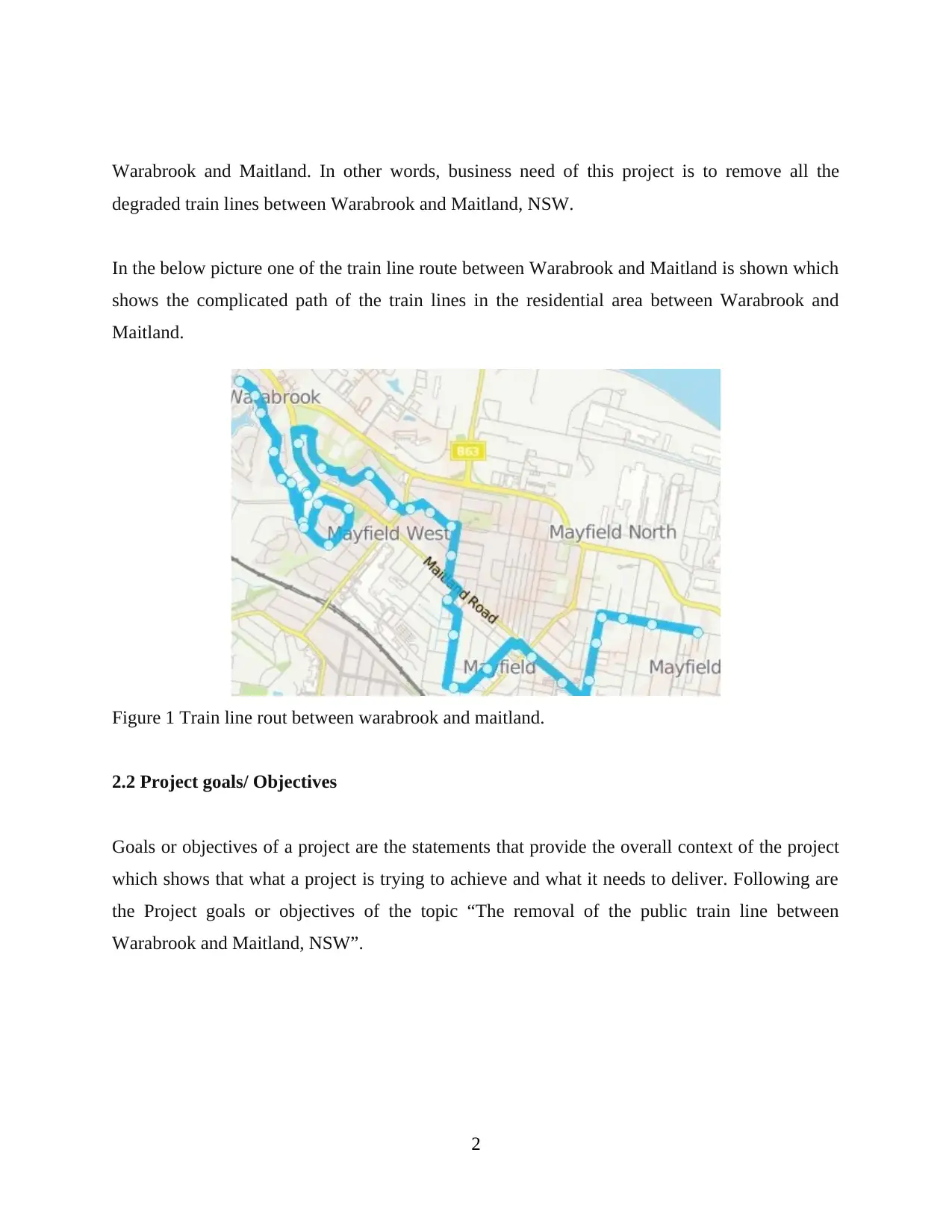
Warabrook and Maitland. In other words, business need of this project is to remove all the
degraded train lines between Warabrook and Maitland, NSW.
In the below picture one of the train line route between Warabrook and Maitland is shown which
shows the complicated path of the train lines in the residential area between Warabrook and
Maitland.
Figure 1 Train line rout between warabrook and maitland.
2.2 Project goals/ Objectives
Goals or objectives of a project are the statements that provide the overall context of the project
which shows that what a project is trying to achieve and what it needs to deliver. Following are
the Project goals or objectives of the topic “The removal of the public train line between
Warabrook and Maitland, NSW”.
2
degraded train lines between Warabrook and Maitland, NSW.
In the below picture one of the train line route between Warabrook and Maitland is shown which
shows the complicated path of the train lines in the residential area between Warabrook and
Maitland.
Figure 1 Train line rout between warabrook and maitland.
2.2 Project goals/ Objectives
Goals or objectives of a project are the statements that provide the overall context of the project
which shows that what a project is trying to achieve and what it needs to deliver. Following are
the Project goals or objectives of the topic “The removal of the public train line between
Warabrook and Maitland, NSW”.
2
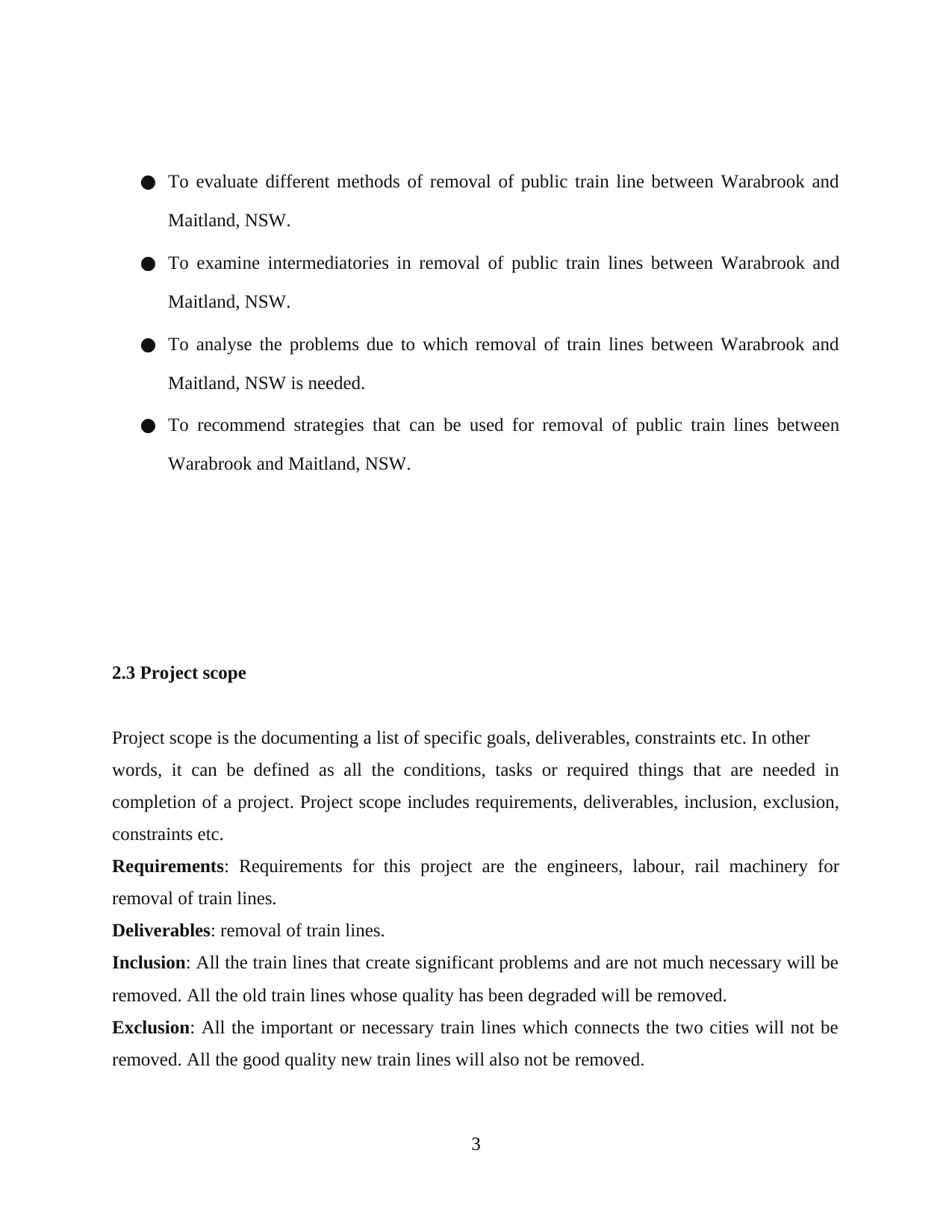
● To evaluate different methods of removal of public train line between Warabrook and
Maitland, NSW.
● To examine intermediatories in removal of public train lines between Warabrook and
Maitland, NSW.
● To analyse the problems due to which removal of train lines between Warabrook and
Maitland, NSW is needed.
● To recommend strategies that can be used for removal of public train lines between
Warabrook and Maitland, NSW.
2.3 Project scope
Project scope is the documenting a list of specific goals, deliverables, constraints etc. In other
words, it can be defined as all the conditions, tasks or required things that are needed in
completion of a project. Project scope includes requirements, deliverables, inclusion, exclusion,
constraints etc.
Requirements: Requirements for this project are the engineers, labour, rail machinery for
removal of train lines.
Deliverables: removal of train lines.
Inclusion: All the train lines that create significant problems and are not much necessary will be
removed. All the old train lines whose quality has been degraded will be removed.
Exclusion: All the important or necessary train lines which connects the two cities will not be
removed. All the good quality new train lines will also not be removed.
3
Maitland, NSW.
● To examine intermediatories in removal of public train lines between Warabrook and
Maitland, NSW.
● To analyse the problems due to which removal of train lines between Warabrook and
Maitland, NSW is needed.
● To recommend strategies that can be used for removal of public train lines between
Warabrook and Maitland, NSW.
2.3 Project scope
Project scope is the documenting a list of specific goals, deliverables, constraints etc. In other
words, it can be defined as all the conditions, tasks or required things that are needed in
completion of a project. Project scope includes requirements, deliverables, inclusion, exclusion,
constraints etc.
Requirements: Requirements for this project are the engineers, labour, rail machinery for
removal of train lines.
Deliverables: removal of train lines.
Inclusion: All the train lines that create significant problems and are not much necessary will be
removed. All the old train lines whose quality has been degraded will be removed.
Exclusion: All the important or necessary train lines which connects the two cities will not be
removed. All the good quality new train lines will also not be removed.
3
⊘ This is a preview!⊘
Do you want full access?
Subscribe today to unlock all pages.

Trusted by 1+ million students worldwide
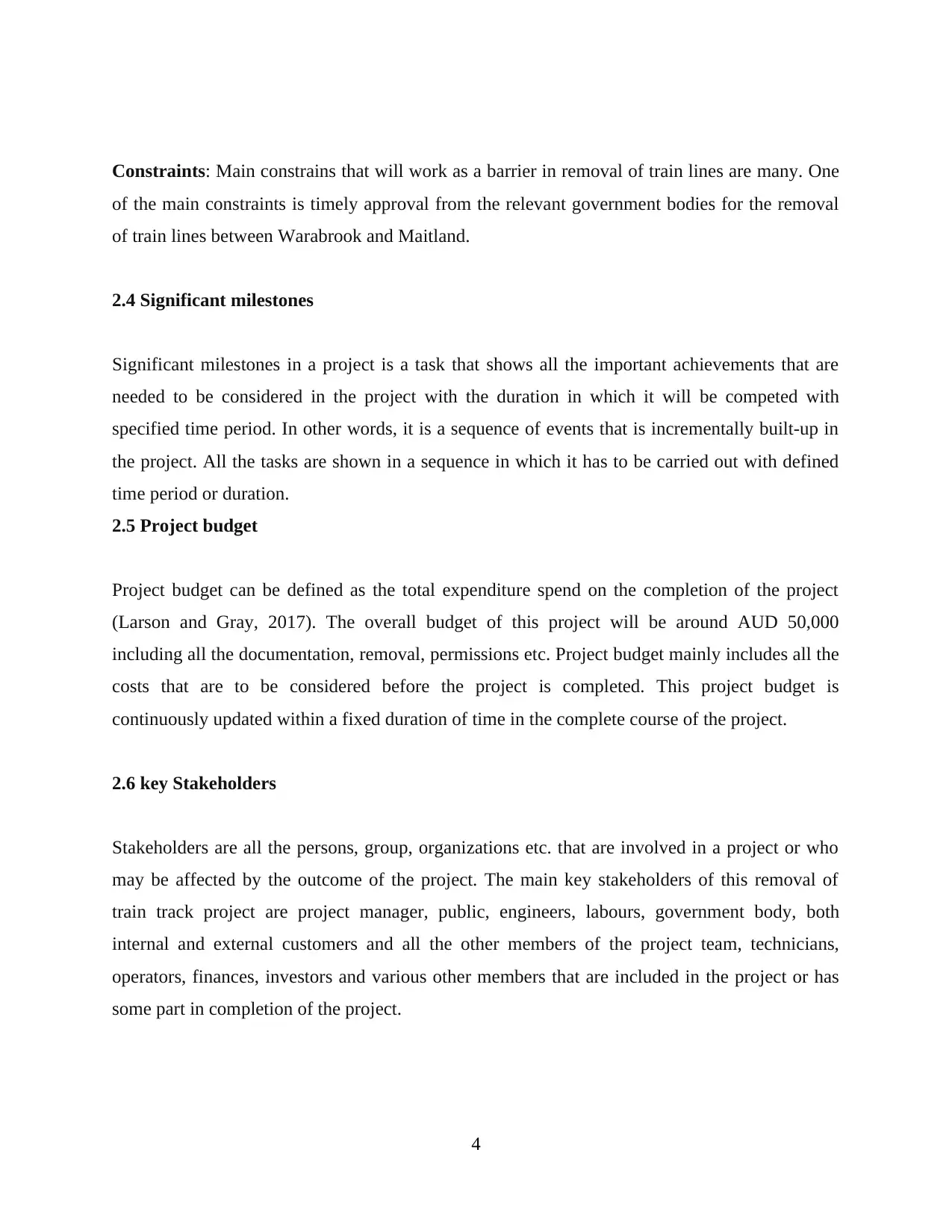
Constraints: Main constrains that will work as a barrier in removal of train lines are many. One
of the main constraints is timely approval from the relevant government bodies for the removal
of train lines between Warabrook and Maitland.
2.4 Significant milestones
Significant milestones in a project is a task that shows all the important achievements that are
needed to be considered in the project with the duration in which it will be competed with
specified time period. In other words, it is a sequence of events that is incrementally built-up in
the project. All the tasks are shown in a sequence in which it has to be carried out with defined
time period or duration.
2.5 Project budget
Project budget can be defined as the total expenditure spend on the completion of the project
(Larson and Gray, 2017). The overall budget of this project will be around AUD 50,000
including all the documentation, removal, permissions etc. Project budget mainly includes all the
costs that are to be considered before the project is completed. This project budget is
continuously updated within a fixed duration of time in the complete course of the project.
2.6 key Stakeholders
Stakeholders are all the persons, group, organizations etc. that are involved in a project or who
may be affected by the outcome of the project. The main key stakeholders of this removal of
train track project are project manager, public, engineers, labours, government body, both
internal and external customers and all the other members of the project team, technicians,
operators, finances, investors and various other members that are included in the project or has
some part in completion of the project.
4
of the main constraints is timely approval from the relevant government bodies for the removal
of train lines between Warabrook and Maitland.
2.4 Significant milestones
Significant milestones in a project is a task that shows all the important achievements that are
needed to be considered in the project with the duration in which it will be competed with
specified time period. In other words, it is a sequence of events that is incrementally built-up in
the project. All the tasks are shown in a sequence in which it has to be carried out with defined
time period or duration.
2.5 Project budget
Project budget can be defined as the total expenditure spend on the completion of the project
(Larson and Gray, 2017). The overall budget of this project will be around AUD 50,000
including all the documentation, removal, permissions etc. Project budget mainly includes all the
costs that are to be considered before the project is completed. This project budget is
continuously updated within a fixed duration of time in the complete course of the project.
2.6 key Stakeholders
Stakeholders are all the persons, group, organizations etc. that are involved in a project or who
may be affected by the outcome of the project. The main key stakeholders of this removal of
train track project are project manager, public, engineers, labours, government body, both
internal and external customers and all the other members of the project team, technicians,
operators, finances, investors and various other members that are included in the project or has
some part in completion of the project.
4
Paraphrase This Document
Need a fresh take? Get an instant paraphrase of this document with our AI Paraphraser
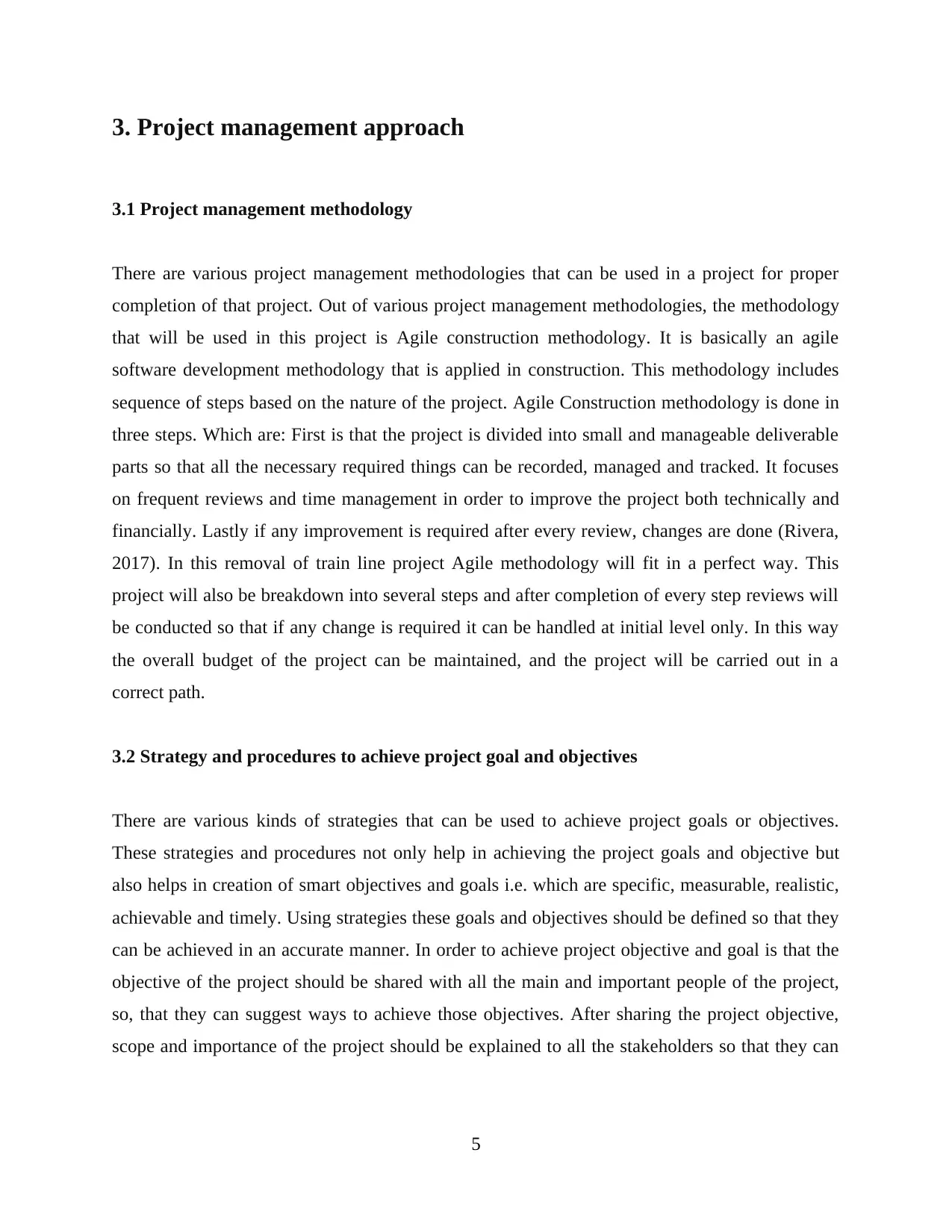
3. Project management approach
3.1 Project management methodology
There are various project management methodologies that can be used in a project for proper
completion of that project. Out of various project management methodologies, the methodology
that will be used in this project is Agile construction methodology. It is basically an agile
software development methodology that is applied in construction. This methodology includes
sequence of steps based on the nature of the project. Agile Construction methodology is done in
three steps. Which are: First is that the project is divided into small and manageable deliverable
parts so that all the necessary required things can be recorded, managed and tracked. It focuses
on frequent reviews and time management in order to improve the project both technically and
financially. Lastly if any improvement is required after every review, changes are done (Rivera,
2017). In this removal of train line project Agile methodology will fit in a perfect way. This
project will also be breakdown into several steps and after completion of every step reviews will
be conducted so that if any change is required it can be handled at initial level only. In this way
the overall budget of the project can be maintained, and the project will be carried out in a
correct path.
3.2 Strategy and procedures to achieve project goal and objectives
There are various kinds of strategies that can be used to achieve project goals or objectives.
These strategies and procedures not only help in achieving the project goals and objective but
also helps in creation of smart objectives and goals i.e. which are specific, measurable, realistic,
achievable and timely. Using strategies these goals and objectives should be defined so that they
can be achieved in an accurate manner. In order to achieve project objective and goal is that the
objective of the project should be shared with all the main and important people of the project,
so, that they can suggest ways to achieve those objectives. After sharing the project objective,
scope and importance of the project should be explained to all the stakeholders so that they can
5
3.1 Project management methodology
There are various project management methodologies that can be used in a project for proper
completion of that project. Out of various project management methodologies, the methodology
that will be used in this project is Agile construction methodology. It is basically an agile
software development methodology that is applied in construction. This methodology includes
sequence of steps based on the nature of the project. Agile Construction methodology is done in
three steps. Which are: First is that the project is divided into small and manageable deliverable
parts so that all the necessary required things can be recorded, managed and tracked. It focuses
on frequent reviews and time management in order to improve the project both technically and
financially. Lastly if any improvement is required after every review, changes are done (Rivera,
2017). In this removal of train line project Agile methodology will fit in a perfect way. This
project will also be breakdown into several steps and after completion of every step reviews will
be conducted so that if any change is required it can be handled at initial level only. In this way
the overall budget of the project can be maintained, and the project will be carried out in a
correct path.
3.2 Strategy and procedures to achieve project goal and objectives
There are various kinds of strategies that can be used to achieve project goals or objectives.
These strategies and procedures not only help in achieving the project goals and objective but
also helps in creation of smart objectives and goals i.e. which are specific, measurable, realistic,
achievable and timely. Using strategies these goals and objectives should be defined so that they
can be achieved in an accurate manner. In order to achieve project objective and goal is that the
objective of the project should be shared with all the main and important people of the project,
so, that they can suggest ways to achieve those objectives. After sharing the project objective,
scope and importance of the project should be explained to all the stakeholders so that they can
5
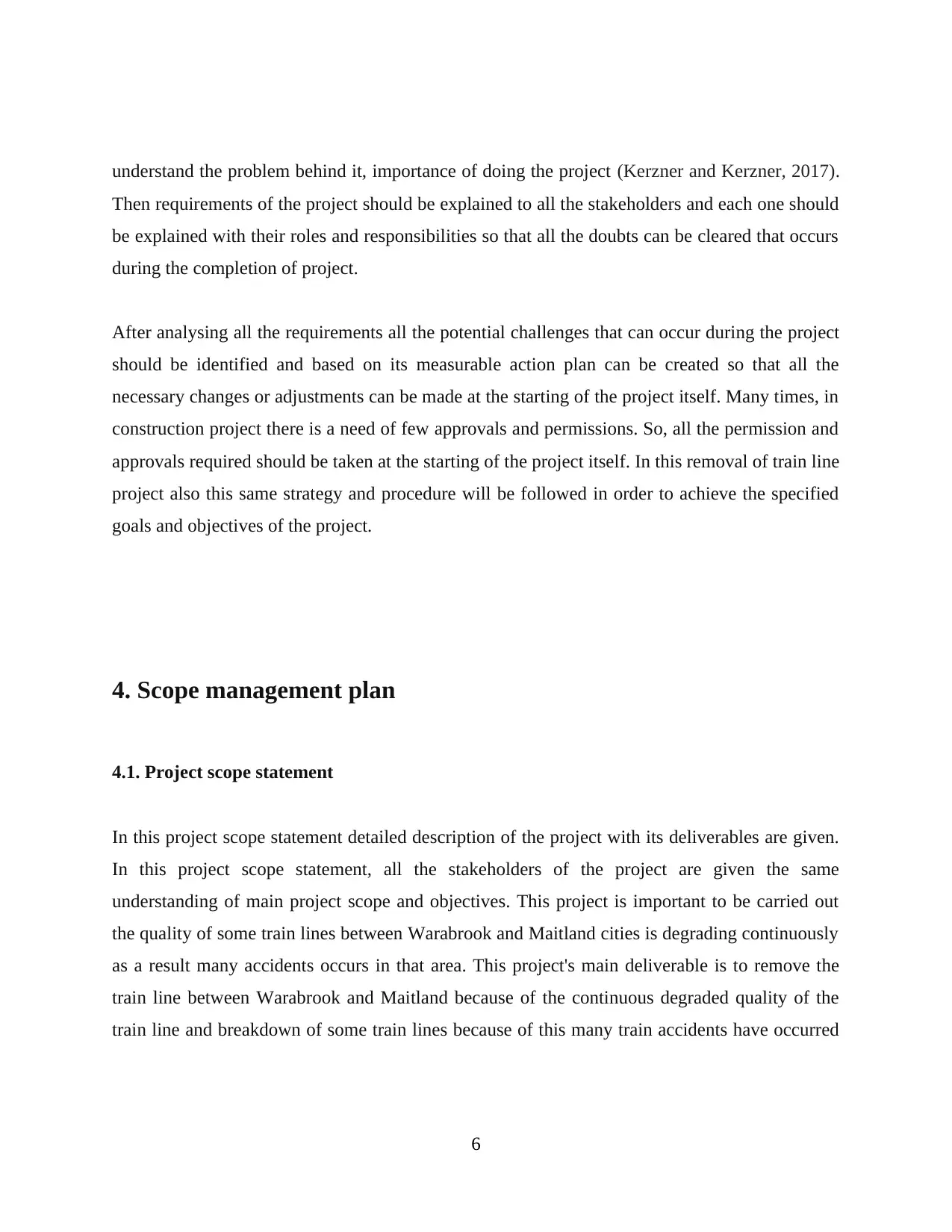
understand the problem behind it, importance of doing the project (Kerzner and Kerzner, 2017).
Then requirements of the project should be explained to all the stakeholders and each one should
be explained with their roles and responsibilities so that all the doubts can be cleared that occurs
during the completion of project.
After analysing all the requirements all the potential challenges that can occur during the project
should be identified and based on its measurable action plan can be created so that all the
necessary changes or adjustments can be made at the starting of the project itself. Many times, in
construction project there is a need of few approvals and permissions. So, all the permission and
approvals required should be taken at the starting of the project itself. In this removal of train line
project also this same strategy and procedure will be followed in order to achieve the specified
goals and objectives of the project.
4. Scope management plan
4.1. Project scope statement
In this project scope statement detailed description of the project with its deliverables are given.
In this project scope statement, all the stakeholders of the project are given the same
understanding of main project scope and objectives. This project is important to be carried out
the quality of some train lines between Warabrook and Maitland cities is degrading continuously
as a result many accidents occurs in that area. This project's main deliverable is to remove the
train line between Warabrook and Maitland because of the continuous degraded quality of the
train line and breakdown of some train lines because of this many train accidents have occurred
6
Then requirements of the project should be explained to all the stakeholders and each one should
be explained with their roles and responsibilities so that all the doubts can be cleared that occurs
during the completion of project.
After analysing all the requirements all the potential challenges that can occur during the project
should be identified and based on its measurable action plan can be created so that all the
necessary changes or adjustments can be made at the starting of the project itself. Many times, in
construction project there is a need of few approvals and permissions. So, all the permission and
approvals required should be taken at the starting of the project itself. In this removal of train line
project also this same strategy and procedure will be followed in order to achieve the specified
goals and objectives of the project.
4. Scope management plan
4.1. Project scope statement
In this project scope statement detailed description of the project with its deliverables are given.
In this project scope statement, all the stakeholders of the project are given the same
understanding of main project scope and objectives. This project is important to be carried out
the quality of some train lines between Warabrook and Maitland cities is degrading continuously
as a result many accidents occurs in that area. This project's main deliverable is to remove the
train line between Warabrook and Maitland because of the continuous degraded quality of the
train line and breakdown of some train lines because of this many train accidents have occurred
6
⊘ This is a preview!⊘
Do you want full access?
Subscribe today to unlock all pages.

Trusted by 1+ million students worldwide
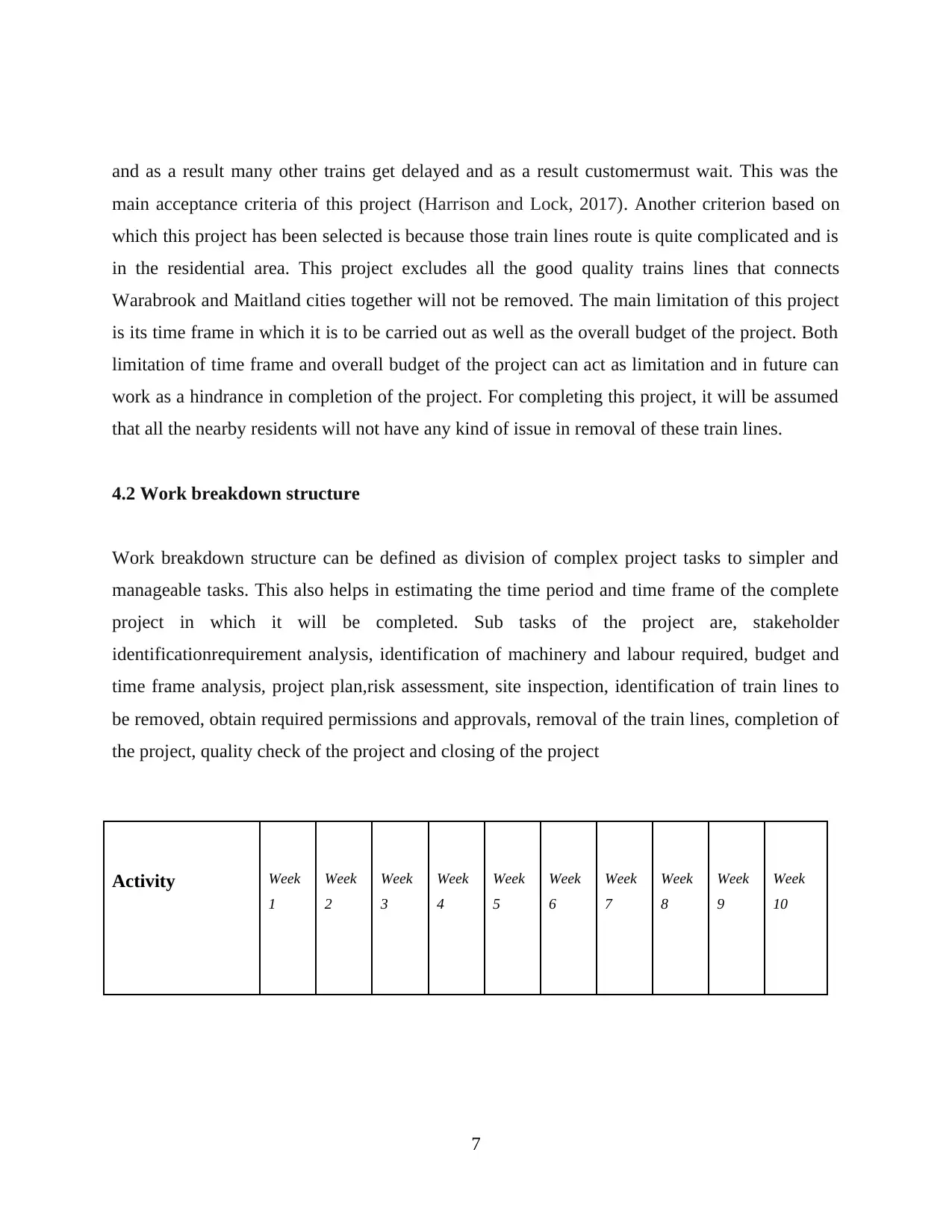
and as a result many other trains get delayed and as a result customermust wait. This was the
main acceptance criteria of this project (Harrison and Lock, 2017). Another criterion based on
which this project has been selected is because those train lines route is quite complicated and is
in the residential area. This project excludes all the good quality trains lines that connects
Warabrook and Maitland cities together will not be removed. The main limitation of this project
is its time frame in which it is to be carried out as well as the overall budget of the project. Both
limitation of time frame and overall budget of the project can act as limitation and in future can
work as a hindrance in completion of the project. For completing this project, it will be assumed
that all the nearby residents will not have any kind of issue in removal of these train lines.
4.2 Work breakdown structure
Work breakdown structure can be defined as division of complex project tasks to simpler and
manageable tasks. This also helps in estimating the time period and time frame of the complete
project in which it will be completed. Sub tasks of the project are, stakeholder
identificationrequirement analysis, identification of machinery and labour required, budget and
time frame analysis, project plan,risk assessment, site inspection, identification of train lines to
be removed, obtain required permissions and approvals, removal of the train lines, completion of
the project, quality check of the project and closing of the project
Activity Week
1
Week
2
Week
3
Week
4
Week
5
Week
6
Week
7
Week
8
Week
9
Week
10
7
main acceptance criteria of this project (Harrison and Lock, 2017). Another criterion based on
which this project has been selected is because those train lines route is quite complicated and is
in the residential area. This project excludes all the good quality trains lines that connects
Warabrook and Maitland cities together will not be removed. The main limitation of this project
is its time frame in which it is to be carried out as well as the overall budget of the project. Both
limitation of time frame and overall budget of the project can act as limitation and in future can
work as a hindrance in completion of the project. For completing this project, it will be assumed
that all the nearby residents will not have any kind of issue in removal of these train lines.
4.2 Work breakdown structure
Work breakdown structure can be defined as division of complex project tasks to simpler and
manageable tasks. This also helps in estimating the time period and time frame of the complete
project in which it will be completed. Sub tasks of the project are, stakeholder
identificationrequirement analysis, identification of machinery and labour required, budget and
time frame analysis, project plan,risk assessment, site inspection, identification of train lines to
be removed, obtain required permissions and approvals, removal of the train lines, completion of
the project, quality check of the project and closing of the project
Activity Week
1
Week
2
Week
3
Week
4
Week
5
Week
6
Week
7
Week
8
Week
9
Week
10
7
Paraphrase This Document
Need a fresh take? Get an instant paraphrase of this document with our AI Paraphraser
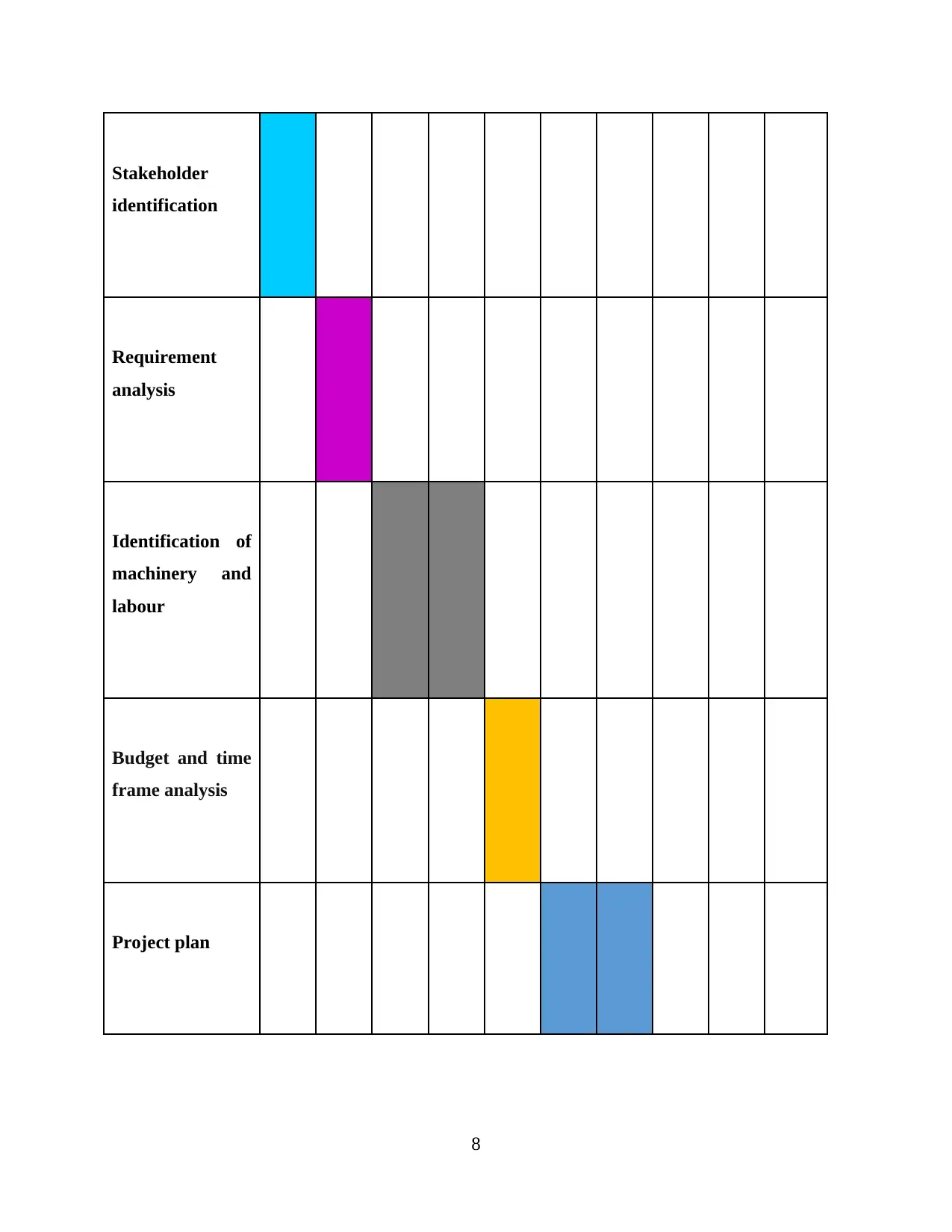
Stakeholder
identification
Requirement
analysis
Identification of
machinery and
labour
Budget and time
frame analysis
Project plan
8
identification
Requirement
analysis
Identification of
machinery and
labour
Budget and time
frame analysis
Project plan
8
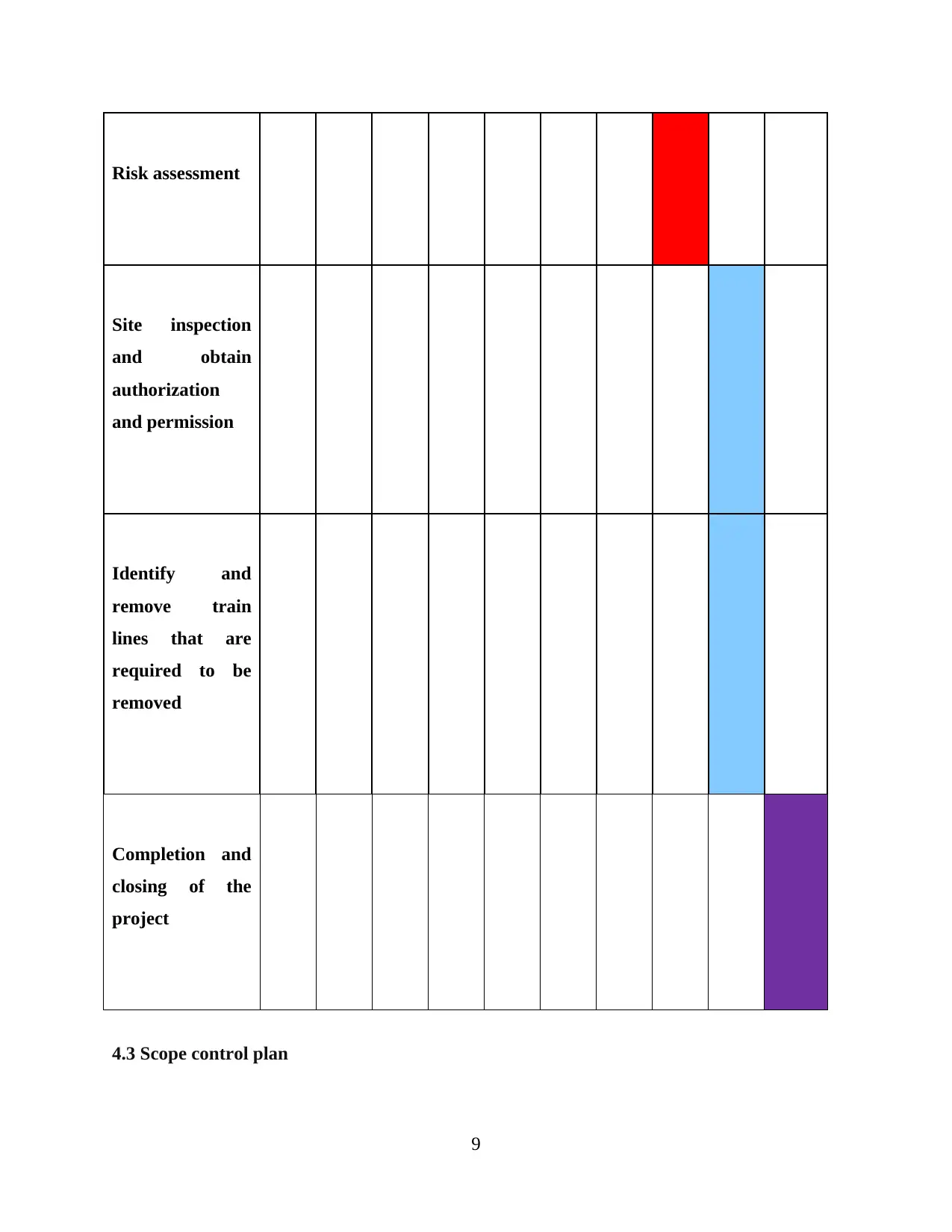
Risk assessment
Site inspection
and obtain
authorization
and permission
Identify and
remove train
lines that are
required to be
removed
Completion and
closing of the
project
4.3 Scope control plan
9
Site inspection
and obtain
authorization
and permission
Identify and
remove train
lines that are
required to be
removed
Completion and
closing of the
project
4.3 Scope control plan
9
⊘ This is a preview!⊘
Do you want full access?
Subscribe today to unlock all pages.

Trusted by 1+ million students worldwide
1 out of 41
Related Documents
Your All-in-One AI-Powered Toolkit for Academic Success.
+13062052269
info@desklib.com
Available 24*7 on WhatsApp / Email
![[object Object]](/_next/static/media/star-bottom.7253800d.svg)
Unlock your academic potential
Copyright © 2020–2025 A2Z Services. All Rights Reserved. Developed and managed by ZUCOL.





